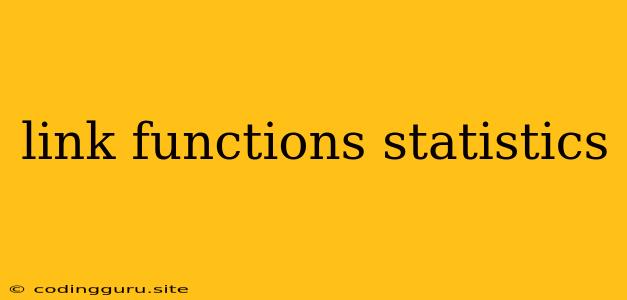Understanding the Power of Link Functions in Statistics
In the realm of statistics, link functions play a crucial role in bridging the gap between the linear world of our models and the often non-linear nature of the real world. But what exactly are link functions, and how do they empower us to analyze data effectively? Let's delve into this fascinating concept.
What are Link Functions?
Imagine you're trying to model a relationship between a response variable and some explanatory variables. You might assume a linear relationship, but what if the data doesn't fit neatly into a straight line? That's where link functions come in.
In essence, a link function transforms the expected value of the response variable (usually denoted as μ) into a linear combination of the explanatory variables. This allows us to use familiar linear techniques while still accommodating the non-linearity of the real world.
Why Use Link Functions?
Link functions offer several key advantages:
- Flexibility: They allow us to model diverse data distributions, including those that are skewed or bounded.
- Interpretability: They can make the relationships between variables more interpretable, even when those relationships are non-linear.
- Consistency with assumptions: Link functions ensure that the model's predictions remain within the valid range of the response variable.
Common Link Functions
Here are some of the most popular link functions used in statistical modeling:
- Identity Link: This is the simplest link function, where the expected value of the response variable is directly equal to the linear combination of the explanatory variables. It's used when we assume a linear relationship between the variables.
- Logit Link: This link function is often used in logistic regression, which models binary outcomes (e.g., success or failure). It transforms the probability of success into a linear combination of the predictors.
- Probit Link: Similar to the logit link, the probit link is also used in logistic regression. It employs the cumulative distribution function of a standard normal distribution to transform the probability of success.
- Log Link: This link function is widely used in Poisson regression, which models count data (e.g., the number of events occurring in a given period). The log link transforms the expected count into a linear combination of the predictors.
Choosing the Right Link Function
The choice of the appropriate link function depends on the nature of the response variable and the underlying assumptions of the model. Here are some factors to consider:
- Distribution of the Response Variable: The distribution of the response variable often dictates the choice of the link function. For example, if the response variable is binary, the logit or probit link is generally preferred.
- Theoretical Background: Some models have theoretical justifications for specific link functions. For instance, Poisson regression often uses the log link due to the inherent multiplicative nature of Poisson processes.
- Data Exploration: Visualizing the data can help determine the relationship between variables and guide the selection of an appropriate link function.
Example: Modeling Disease Prevalence
Let's imagine we're studying the prevalence of a disease and its relationship with certain environmental factors. We might use a logistic regression model with a logit link function to model the probability of developing the disease. This model would allow us to investigate how different environmental factors influence the disease's prevalence.
Link Functions in Action
Link functions are crucial for many statistical models, including:
- Generalized Linear Models (GLMs): GLMs utilize link functions to connect the linear predictor to the mean of the response variable, enabling flexible modeling of various response distributions.
- Logistic Regression: This widely used model for binary outcomes relies on link functions like the logit or probit to transform probabilities into linear combinations of predictors.
- Poisson Regression: For count data, Poisson regression utilizes link functions like the log link to model the expected count as a linear combination of predictors.
Conclusion
Link functions are fundamental tools in statistical modeling. They allow us to model non-linear relationships while leveraging the power of linear techniques. By carefully considering the nature of the response variable and the underlying assumptions of the model, we can choose the appropriate link function to effectively analyze data and gain valuable insights.
